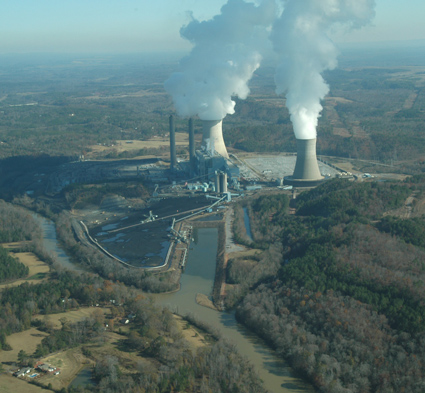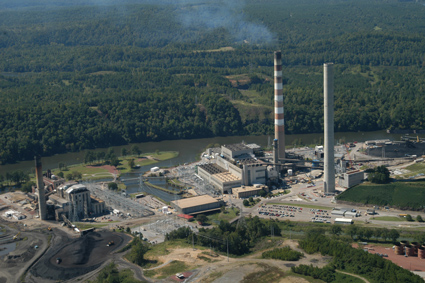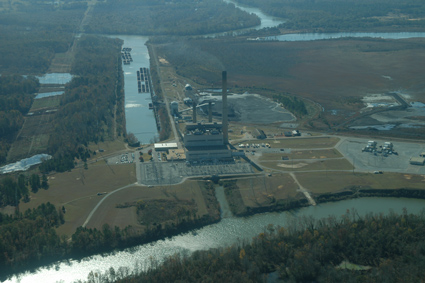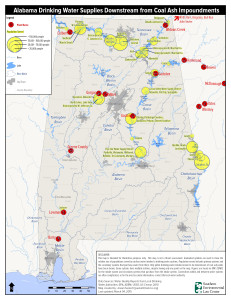UPDATE May 23, 2024: EPA finalizes denial of Alabama’s coal ash permitting program
Three major steam power plants are located in the Black Warrior River watershed: Miller Steam Plant, Gorgas Steam Plant, and Greene County Steam Plant. All three at one point burned coal to produce electricity, so they have onsite waste storage pits for the resulting coal ash. Coal ash is the toxic waste that remains after coal is burned. It contains high concentrations of heavy metals, including mercury, arsenic, selenium, chromium, and radium, which are hazardous to human health, wildlife, and waterways.
Miller Steam Plant is located right next to where Village Creek flows into the Locust Fork of the Black Warrior, near the town of West Jefferson in Jefferson County, AL. Miller is the largest coal-burning power plant in Alabama and has the dubious distinction of being the #1 CO2 emitter in the United States. Miller’s 19.5 million tons of coal ash are stored in a 321-acre unlined storage pond along the river behind a 170 foot tall earthen dam. The toxic ash pond was built on top of two streams that feed into the Locust Fork. On average during 2018, the maximum daily discharge of coal ash wastewater from Miller’s ash pit into the Locust Fork of the Black Warrior River was approximately 11.51 million gallons. Alabama Power plans to de-water the facility from 2020 through July 2025, with a final closure date estimated May 2027.
Toxic Coal Ash: CCR Compliance Data | Inundation map | Emergency Action Plan
Plant Miller | CCR Closure Permit 37-51 | SELC, ARA, BWRk Comments | 10/27/20
 Alabama Power’s Plant Miller on the Locust Fork of the Black Warrior River. (Jefferson Co.)
Alabama Power’s Plant Miller on the Locust Fork of the Black Warrior River. (Jefferson Co.)
Photo by Nelson Brooke. Flight provided by SouthWings.
Gorgas Steam Plant is situated on both sides of Baker Creek along the Mulberry Fork of the Black Warrior, near the community of Goodsprings in Walker County, AL. Gorgas is the oldest coal-burning power plant in the state, originally constructed in 1914. More than 40 million tons of coal ash have been dumped into Rattlesnake Lake, a 420-acre unlined impoundment formed by damming Rattlesnake Creek in 1953. On average during 2018, the maximum daily discharge of coal ash wastewater from Rattlesnake Lake into the Mulberry Fork of the Black Warrior River was approximately 28.49 million gallons. Alabama Power has announced its intent to begin closure of the Rattlesnake Lake coal ash dump in 2019, with final closure anticipated in 2028.
Toxic Coal Ash: CCR Compliance Data | Inundation Map | Emergency Action Plan
Plant Gorgas | U.S. Army Corps of Engineers 404 Permit | SELC, BWRk Comments | 12/16/19
 Alabama Power’s Plant Gorgas on the Mulberry Fork of the Black Warrior River. (Walker Co.)
Alabama Power’s Plant Gorgas on the Mulberry Fork of the Black Warrior River. (Walker Co.)
Photo by Nelson Brooke.
Greene County Steam Plant is situated in a large bend of the Black Warrior, just upriver of Demopolis in Greene County, AL. More than 16 million tons of coal ash have been placed in a 489-acre unlined storage pit, located on top of what once was Big Slough and associated wetlands, which feed into Backbone Creek, a tributary to the Black Warrior River. On average during 2018, the maximum daily discharge of coal ash wastewater from Greene County ash pit into the Black Warrior River was approximately 1.5 million gallons. Closure of the pit has already begun, with the facility initiating the de-watering process in April of 2019. Alabama Power anticipates that the cap-in-place procedure will be finished by 2024.
Toxic Coal Ash: CCR Compliance Data | Inundation map | Emergency Action Plan
Plant Greene County | CCR Closure Permit 32-03 | SELC, ARA, BWRk Comments | 10/29/20
 Alabama Power’s Plant Greene County on the Black Warrior River. (Greene Co.)
Alabama Power’s Plant Greene County on the Black Warrior River. (Greene Co.)
Photo by Nelson Brooke.
To view a Google map created by Riverkeeper showing the power plant’s locations, click here.
 This map shows Alabama drinking water sources downstream from coal-fired power plants’ coal ash waste impoundments, which discharge tens of millions of gallons of polluted wastewater into Alabama’s water resources every day.
This map shows Alabama drinking water sources downstream from coal-fired power plants’ coal ash waste impoundments, which discharge tens of millions of gallons of polluted wastewater into Alabama’s water resources every day.
For more information about coal ash threats to Alabama’s waterways:
To read our 2020 report, updated in 2021 ~ Coal Ash Pollution on the Black Warrior River ~ on the dangers of coal ash, click here.
To read a summary of our 2020 report, updated in 2021 ~ Coal Ash Pollution on the Black Warrior River ~ on the dangers of coal ash, click here.
Take Action! @ alabamacoalash.org/
https://www.coosariver.org/coalashcontaminationagain/
https://alabamarivers.org/project/coal-ash/
https://www.southernenvironment.org/cases-and-projects/coal-waste
http://www.southeastcoalash.org/
https://earthjustice.org/advocacy-campaigns/coal-ash
https://www.sierraclub.org/topics/coal-ash
For John Wathen’s photo of TVA’s 2008 coal ash spill, click here. (Flight by SouthWings.org)
Miller Steam Plant emitted more mercury in 2007 than any other coal-burning power plant in the country, according to EPA data compiled by the Environmental Integrity Project. Gorgas Steam Plant ranked 28th in this category (Total Mercury Pounds Emitted: 2007). In the category of “Top 50 US Power Plant Mercury Emitters by Pounds per GWh: 2007” Greene County Steam Plant ranked 8th, Miller Steam Plant ranked 15th, and Gorgas Steam Plant ranked 19th.
EPA cites coal-burning power plants as the leading source of mercury air emissions, which end up in the tissue of fish people eat. A potent neurotoxin, mercury is especially dangerous to children and developing fetuses. Coal-burning power plants are also major emitters of air pollutants, including carbon dioxide (CO2), sulfur dioxide (SO2), nitrogen oxide (NOx), volatile organic compounds (VOCs), heavy metals (i.e. mercury & arsenic), and fine particulate matter (PM2.5).
Gasp, a nonprofit advocating for cleaner air in Alabama, has a widget on their website that you can use to check local air quality.
For more information about coal in the Black Warrior River watershed, click here.
In late 2020, Black Warrior Riverkeeper collaborated with Alabama Rivers Alliance and Southern Environmental Law Center to send public comments to the Alabama Department of Environmental Management, alerting the Department to the many reasons that allowing Alabama Power to leave its toxic coal ash in wetlands and streams along the banks of our rivers is a bad idea. To our comment letter regarding Plant Miller, click here. For our comment letter regarding Plant Greene County, click here. Stay tuned for our comment letter regarding Plant Gorgas.












